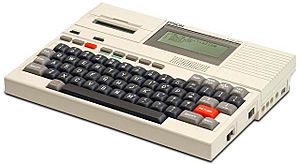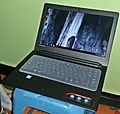Laptop facts for kids
A laptop is a type of computer that is easy to carry around. You can fold it along its hinge to make it compact for travel. Laptops were created to be portable, so all their parts were made smaller than those in a regular desktop computer.
Contents
How Laptops Were Invented
The first laptop was designed in 1979 by a British designer named Bill Moggridge. A company called GRiD Systems Corporation helped make his design better. They created a product called the GriD Compass. It had a screen that folded down to cover the keyboard.
In 1982, GRiD Systems started making many GriD Compass laptops. They mostly sold them to the US Military and NASA. This computer was much lighter than other computers at the time. NASA even used it in their Space Shuttle program in the 1980s. The original Grid Compass needed to be plugged into a power outlet.
GRiD owned patents for the "Clamshell" design. This is the folding design used in almost all modern laptops today. Tandy Corporation bought GRiD Systems in 1988.
Some historians say the first "true" portable computer was the Osborne 1. It was made in 1981 by Adam Osborne, who started Osborne Computer. This portable computer weighed about 24 pounds (11 kilograms). It had a small five-inch screen, a serial port, and two floppy disk drives. It also came with several programs and an optional one-hour battery pack.

Also in 1981, another portable computer called the Epson HX-20 went on sale. It was a portable computer with a liquid crystal display (LCD) screen. It even had a small printer built-in and could run on batteries.
A year later, in 1982, two computer designers from Microsoft, Kazuhiko Nishi and Bill Gates, talked about a new portable computer. They were excited about new LCD screen technology. They showed a test version of their new laptop to Radio Shack. Radio Shack agreed to start making the computer.
A year later, Radio Shack launched its TRS-80 Model 100. This computer looked a lot like the laptops we use today. In 1986, they made an improved version called the TRS Model 200. The next two years saw new laptops from Compaq Computers and the first "notebook-style" laptop from NEC, called the NEC UltraLite.
The year 1989 was a big year for laptop makers. First, Apple Computer developed its first portable computer, the Macintosh Portable. This later led to the PowerBook series. Then, Zenith Data Systems introduced the Zenith MinisPort, which weighed only 6 pounds (2.5 kilograms). Finally, Compaq Computer designed its first laptop PC called the Compaq LTE.
Laptops continued to get many upgrades and new features over the years.
Why Laptops Are Great (and Not So Great)
Laptops have many good things about them:
- You can carry them almost anywhere, whether you're going to school, the office, or a friend's house.
- They take up less space than a regular desktop computer, so you can use them in smaller areas.

But portable computers also have some downsides:
- They often cost more money than desktop computers with similar power.
- Because they are portable, laptops are easier to steal.
- They can break more easily than desktop computers because they are moved around a lot.
- Some cheaper laptops might not be as powerful as desktop computers for tasks like gaming, video editing, or graphic design.
In 2005, an organization called One Laptop Per Child started a project. They wanted to improve education by providing inexpensive laptops to children around the world.
After 2010, people started buying fewer laptops because tablet computers became popular. Tablets are even easier to carry around.
Images for kids
-
Two laptops: Dell XPS 15 9570 and Microsoft Surface Pro 7 running on Windows 10
-
A Chromebook 11 laptop by Acer Inc.
-
A MacBook Air laptop by Apple Inc.
-
Alan Kay holding the mockup of his Dynabook concept in 2008
-
A Siemens PCD-3Psx laptop, released in 1989
-
Apple MacBook Air, an "ultraportable" laptop weighing under 3.0 lb (1.36 kg)
-
Lenovo's IdeaPad laptop
-
Lenovo's ThinkPad business laptop, originally an IBM product
-
Alienware gaming laptop with backlit keyboard and touch pad
-
Miniaturization: a comparison of a desktop computer motherboard (ATX form factor) to a motherboard from a 13" laptop (2008 unibody MacBook)
-
Interfaces on a ThinkPad laptop (2011): Ethernet network port (center), VGA (left), DisplayPort (top right) and USB 2.0 (bottom right). Due to the trend towards very flat laptops and the widespread use of WLAN, the relatively high Ethernet socket is no longer mandatory in today's devices, as is the technically outdated VGA.
-
A modem PCMCIA card on an old ThinkPad. The card would normally fully insert into the socket.
-
A clogged heat sink on a laptop after 2.5 years of use
See also
 In Spanish: Computadora portátil para niños
In Spanish: Computadora portátil para niños





























